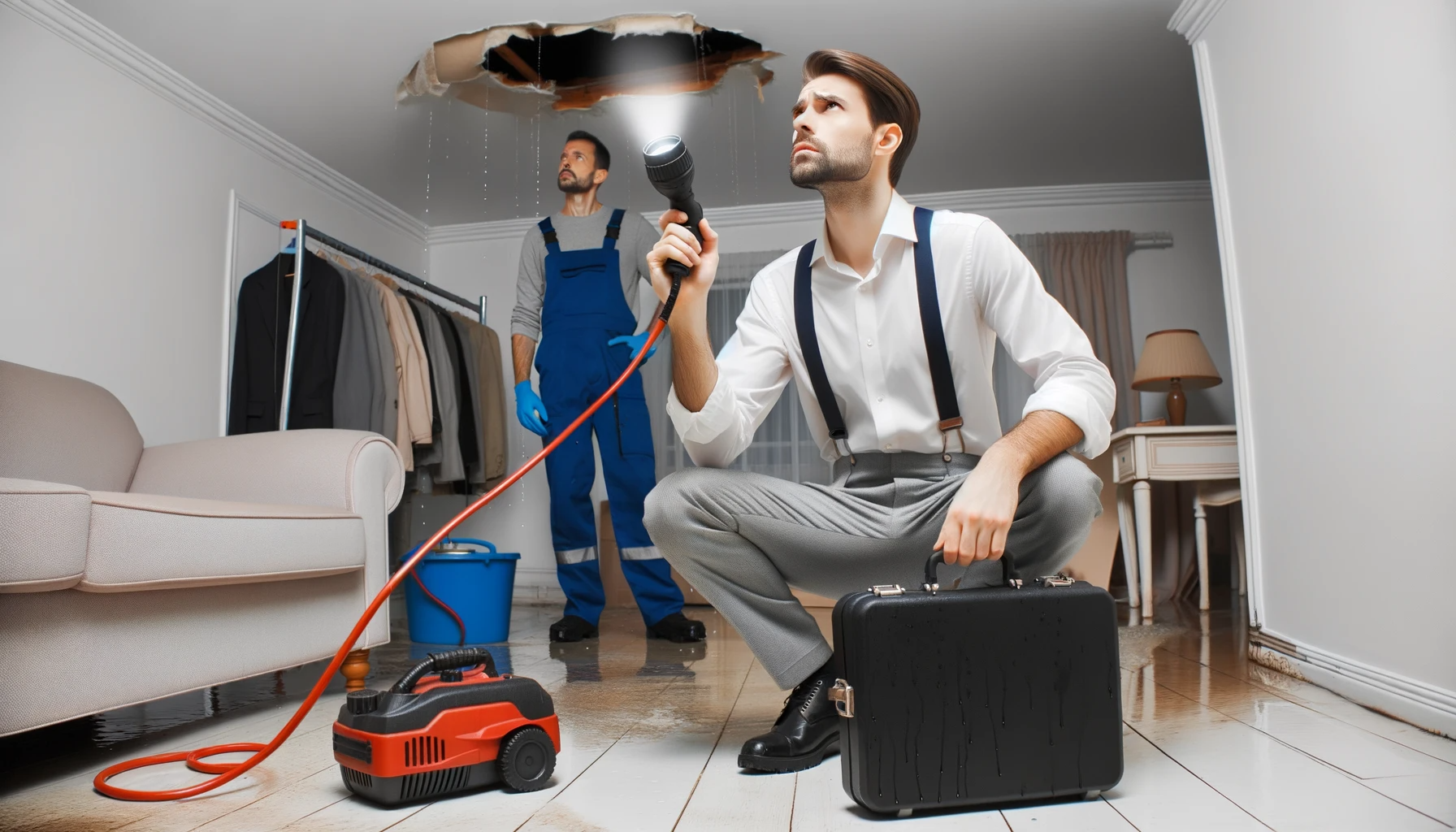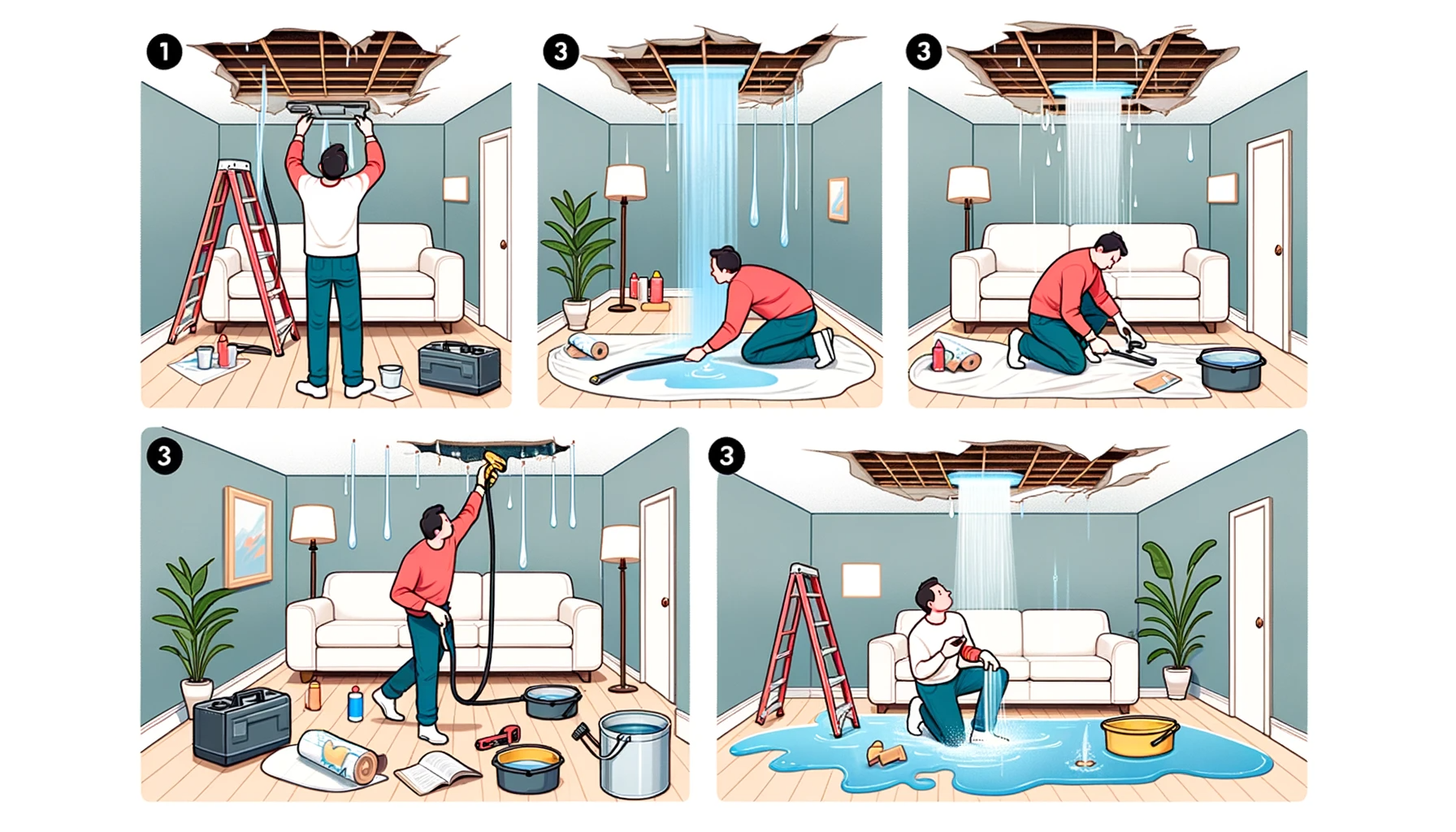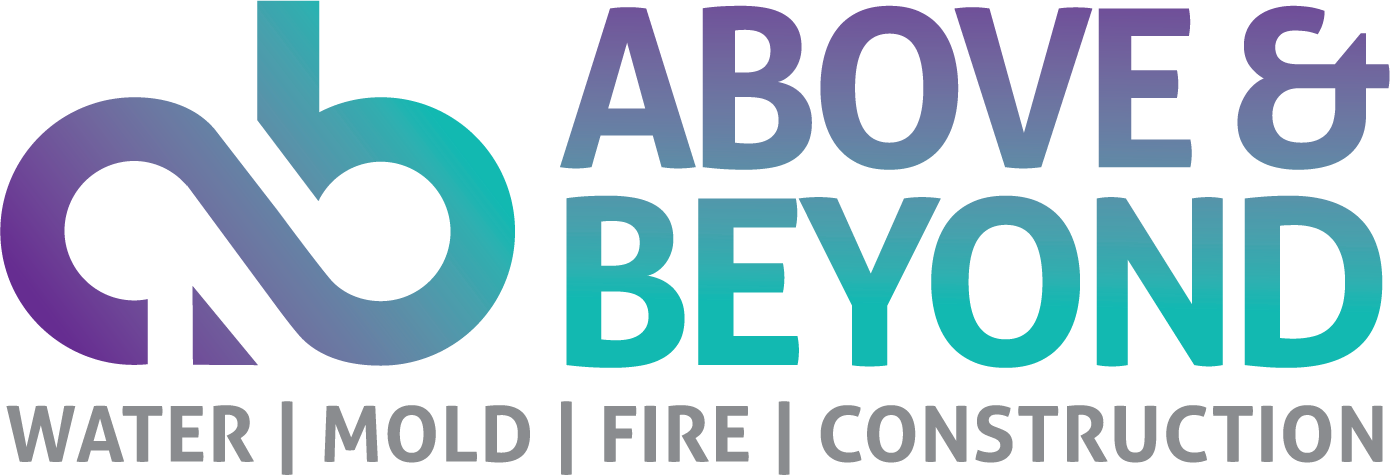Ceiling Water Damage Repair Guide
Above & Beyond Are You Go-To Experts For Property Damage Services Since 1999
Contents
Water damage can be a homeowner’s worst nightmare, and when it infiltrates the ceiling, it brings a unique set of challenges. A leaky roof, burst pipe, or even a small unnoticed drip can wreak havoc on your ceiling, leading to unsightly stains, structural damage, and the ever-looming threat of mold growth.
But fear not, for in the face of ceiling water damage, knowledge is your greatest ally. Whether you’re a DIY enthusiast looking to tackle the repairs yourself or contemplating the merits of hiring a professional, this comprehensive guide is your roadmap to understanding, addressing, and ultimately conquering the issue of ceiling water damage.

We’ll delve into the intricate world of ceiling water damage repair. From identifying the telltale signs to mastering the tools and techniques needed for restoration, we’ve got you covered. We’ll explore prevention strategies, insurance claims, and even eco-friendly solutions for the environmentally conscious.
Ceiling water damage doesn’t have to be a source of stress and uncertainty. With the right knowledge and guidance, you can restore your ceiling to its former glory, safeguard your home against future damage, and regain peace of mind.
Common Causes of Ceiling Water Damage
1. Roof Leaks: One of the primary reasons for ceiling water damage is a leaky roof. This can be caused by missing or damaged shingles, deteriorated flashing, or even a roof that has reached the end of its lifespan. When rainwater seeps through the roof, it can pool in the attic or upper levels of your home, eventually finding its way down to the ceiling.
2. Plumbing Issues: Faulty or damaged plumbing is another frequent source of ceiling water damage. Leaking pipes, burst water lines, or malfunctioning fixtures can lead to water seeping into the walls and ceilings. Often, these leaks are hidden until visible damage becomes apparent.
3. Clogged Gutters and Downspouts: When gutters and downspouts become clogged with debris, rainwater can overflow and cascade down the sides of your home. This water can eventually penetrate the walls and saturate the ceiling, causing water damage over time.
4. Condensation: In humid climates or poorly ventilated areas, condensation can form within your ceiling structure. Over time, this moisture can lead to water damage and even mold growth within the ceiling.
5. Ice Dams: In colder regions, ice dams can form on the roof’s edge, preventing melting snow from draining properly. As the ice melts and refreezes, it can force water beneath the roof shingles, leading to leaks and ceiling water damage.
6. HVAC Issues: Air conditioning units and heating systems can sometimes develop condensation or leaks. If not properly maintained, this moisture can seep into the ceiling and cause damage over time.
7. Flashing Problems: Flashing is the metal or other material used to seal roof penetrations like chimneys, vents, and skylights. When flashing becomes damaged or improperly installed, it can allow water to enter your home and damage the ceiling.
Signs of Ceiling Water Damage
Recognizing the signs of ceiling water damage early is key to preventing further deterioration and costly repairs. Water damage can be subtle, often starting small and gradually becoming more noticeable. By being vigilant, you can identify these warning signs and take action before the problem escalates. Here are the most common signs of ceiling water damage:
-
Water Stains: Discolored patches or yellowish-brown stains on your ceiling are a clear indication of water damage. These stains can vary in size and shape and often appear irregular.
-
Sagging or Bulging: A sagging or bulging area on your ceiling is a sign that water has accumulated and compromised the structural integrity of the ceiling material. This is a serious issue that should be addressed promptly.
-
Peeling Paint or Wallpaper: Water can cause paint or wallpaper to peel away from the surface. If you notice peeling or bubbling in these materials, it may be due to underlying water damage.
-
Dripping Water: In severe cases, you might see water actively dripping or trickling from the ceiling. This is an urgent situation that requires immediate attention to prevent further damage.
-
Mold or Mildew Growth: The presence of mold or mildew on your ceiling is a sure sign of excessive moisture. Mold can be harmful to your health and should be addressed as soon as possible.
-
Musty Odor: A persistent musty or damp smell in a room can indicate hidden water damage. Even if you can’t see any visible signs, it’s essential to investigate further if you notice this odor.
-
Cracked or Bubbling Ceiling Texture: The texture on your ceiling, such as popcorn or stippling, can become cracked or bubbled when exposed to water. These changes in texture are telltale signs of water damage.
-
Increased Utility Bills: If you experience an unexplained increase in your water or energy bills, it could be due to a hidden water leak in your ceiling, causing your HVAC system to work harder.
-
Deteriorating Ceiling Materials: Water can weaken ceiling materials like drywall or plaster, causing them to become soft, crumble, or disintegrate upon touch.
-
Visible Water Source: Sometimes, the source of the water damage may be visible, such as a leaking pipe or a damaged roof. Identifying and fixing the source is crucial to prevent further ceiling damage.
It’s essential to address these signs promptly to prevent further damage to your ceiling and the potential for mold growth, which can pose health risks.
Temporary Measures for Emergency Ceiling Water Damage

When faced with a sudden and unexpected ceiling water leak, taking immediate action is crucial to prevent further damage to your home and belongings. These temporary measures can help mitigate the emergency situation until you can arrange for proper repairs:
-
Safety First: Before addressing the ceiling leak, ensure your safety. Turn off the electricity to the affected area if water has come into contact with electrical fixtures or wiring.
-
Identify and Stop the Source: If possible, locate the source of the water leak and take steps to stop it. This might involve turning off the water supply to a broken pipe, patching a roof leak, or tightening a loose plumbing connection.
-
Contain the Water: Place buckets, pans, or large containers under the dripping or leaking area to catch and contain the water. Empty them regularly to prevent overflow.
-
Poke a Hole: If there’s a bulging area in your ceiling due to trapped water, carefully puncture a small hole in the center using a screwdriver or awl. This will allow the trapped water to drain into a container and relieve pressure on the ceiling.
-
Move Belongings: Safeguard any furniture, electronics, or valuables in the affected area by moving them away from the water source. Cover them with plastic sheets or tarps if necessary.
-
Protect Flooring: If water is dripping onto the floor, use towels, rags, or more containers to absorb and redirect the water away from the floor. This prevents water damage to your flooring.
-
Remove Damaged Ceiling Material: If the ceiling is sagging or bulging significantly, carefully remove the damaged material using a utility knife. This will prevent it from collapsing suddenly.
-
Promote Ventilation: Open windows and doors to enhance air circulation and encourage the drying process. Using fans or dehumidifiers can also help accelerate drying.
-
Address Mold Prevention: If there’s any suspicion of mold growth, use a mold-inhibiting cleaner or white vinegar and water solution to clean the affected area. This temporary measure can help minimize mold development until proper remediation can occur.
-
Contact Professionals: After taking these immediate steps, it’s crucial to contact a professional water damage restoration service or a qualified contractor to assess the extent of the damage and plan for comprehensive repairs.
Remember that these temporary measures are just a stopgap solution to mitigate the emergency situation. Ceiling water damage can lead to more significant problems, including structural issues and mold growth, if not properly addressed. Professional assistance should be sought to ensure thorough and lasting repairs.
Essential Tools for Ceiling Water Damage Repair
Repairing ceiling water damage requires the right tools to ensure a successful and efficient restoration process. Whether you’re tackling the repairs yourself or working alongside professionals, having the following essential tools at your disposal is crucial:
-
Safety Gear: Safety should always come first. Equip yourself with safety goggles, a dust mask, gloves, and a hard hat to protect against potential hazards during the repair process.
-
Ladder: A stable ladder with adjustable height is essential for accessing and working on the damaged ceiling. Ensure it’s positioned securely on a level surface.
-
Utility Knife: A sharp utility knife will help you cut away damaged drywall, insulation, or ceiling material cleanly and precisely.
-
Drywall Saw: This tool is designed for cutting through drywall and is essential for creating clean openings when removing damaged sections.
-
Screwdriver and Screws: Use a screwdriver to secure loose or damaged ceiling panels or drywall. Keep a variety of screws on hand for different applications.
-
Pry Bar: A pry bar is handy for carefully removing damaged ceiling materials without causing unnecessary collateral damage.
-
Putty Knife: Use putty knives for applying joint compound or patching materials when repairing ceiling cracks or holes.
-
Drywall Trowel: A drywall trowel helps you evenly spread joint compound when repairing or finishing the ceiling’s surface.
-
Drywall Tape: Mesh or paper drywall tape is essential for reinforcing seams and joints between pieces of drywall.
-
Joint Compound: Choose the appropriate joint compound for your ceiling repair needs, whether it’s for filling holes or finishing seams.
-
Paint and Paintbrushes: If your ceiling has been painted, you’ll need matching paint and brushes to restore its appearance after repairs.
-
Ceiling Texture Tools: If your ceiling has a textured finish, you may need specialized tools like texture brushes, rollers, or sprayers to replicate the original texture.
-
Moisture Meter: A moisture meter helps you determine if the affected areas are adequately dried before starting repairs to prevent mold growth.
-
Fans and Dehumidifiers: These appliances are crucial for drying out the area thoroughly, especially if extensive water damage occurred.
-
Electrical Tester: If there are electrical fixtures or wiring in the ceiling, an electrical tester is essential to ensure safety during repairs.
-
Flashlight: Adequate lighting is essential for a thorough inspection of the damaged area and for working in tight spaces.
-
Plastic Sheeting and Drop Cloths: Protect your workspace and furnishings by covering them with plastic sheeting or drop cloths to catch debris and dust.
-
Buckets and Sponges: Use buckets for mixing joint compound and sponges for cleaning surfaces and tools.
-
Extension Cords: Ensure you have enough extension cords to reach power sources, as you may need additional lighting or equipment.
Having these essential tools on hand will make your ceiling water damage repair project more manageable and efficient. Depending on the extent of the damage and the specific repairs required, you may also need additional specialized tools or materials.
When to Call a Professional for Ceiling Water Damage:
Ceiling water damage can range from minor issues like small stains to severe structural damage. While some minor cases can be addressed with DIY efforts, there are specific situations where it’s essential to call a professional:
-
Extensive Damage: If the water damage covers a large area of your ceiling or spans multiple rooms, it’s best to consult a professional. Extensive damage often indicates a more complex issue, such as a major roof leak or widespread plumbing problem.
-
Structural Compromise: When your ceiling shows signs of sagging, bulging, or visible structural damage, a professional assessment is critical. Structural issues require expertise to ensure that your ceiling is safe and secure.
-
Hidden Water Sources: If you can’t identify the source of the water leak or it’s hidden within the ceiling or walls, professionals have the tools and knowledge to locate and address the problem without causing unnecessary damage to your home.
-
Mold Growth: If you discover mold on your ceiling or suspect its presence, it’s crucial to hire a professional mold remediation specialist. Mold can pose serious health risks, and its removal should be handled by experts following proper safety protocols.
-
Electrical Hazards: If water damage has affected electrical fixtures, wiring, or outlets in your ceiling, it’s extremely dangerous to handle these situations yourself. A professional electrician should be called to assess and address any electrical issues.
-
Insurance Claims: Dealing with insurance claims related to ceiling water damage can be complicated. Professionals can provide documentation, estimates, and expertise to navigate the claims process successfully.
-
Complex Repairs: Repairing or replacing damaged drywall, insulation, or ceiling materials can be challenging and time-consuming. Professionals have the experience and tools to ensure that repairs are done correctly and seamlessly.
-
Chronic or Recurring Issues: If you’ve had multiple incidents of ceiling water damage or recurrent leaks, professionals can conduct a thorough inspection to identify and address underlying issues, preventing future damage.
-
Health Concerns: If you or your family members experience health issues related to the water damage, such as respiratory problems or allergies, it’s essential to consult professionals for a proper assessment and remediation.
-
Time Constraints: If you have limited time to address the issue due to work, travel, or other commitments, professionals can expedite the repair process and ensure it’s completed efficiently.
Calling a professional for ceiling water damage ensures that the underlying causes are identified and resolved, preventing further damage and potential health hazards. Additionally, professionals have the expertise to restore your ceiling to its pre-damaged condition, ensuring a safe and aesthetically pleasing result.
Serving The Area Since 1999
With years of experience in the industry, we understand the complexities of water damage and its potential consequences. That’s why we approach each restoration project with a comprehensive and systematic approach. Our experts will assess the extent of the damage, create a tailored restoration plan, and execute it with utmost professionalism.
Don’t Let Disasters Take Control – Restore Your Property with Above & Beyond
Call now for a free consultation and get your property restored the right way the first time.



